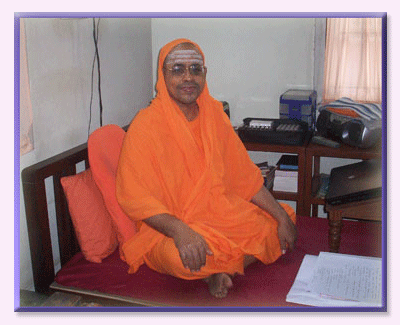UPANISHAD MANDUKYA : Chapter-1. Agama Prakarana : Upanishad Mantram-7 : Karika Mantram-s 10 to 18 : Karika Mantram -18.
-----------------------------------------------------------------------------------------------
Sunday, August 09, 2020.3:32.PM.
Mandukya Upanishad :
Chapter-1. Agama Prakarana ( The Scriptural Treatise )
Sri Gaudapada's glossary :
Upanishad Mantram-7.
Karika Slokam-s 10 to 18.
Karika Slokam-18.
--------------------------------------------------------------------------------------------------
Slokam-18.
"Vikalpo vini-varteta kalpito yadi kenacit,
upadesa-dayam vado jnate dvaitam na vidyate."
--------------------------------------------------------------------------------------------------------
Slokam Translation :
Vikalpah = diversity;
vini-varteta = would go away, disapear;
kalpitah = imagined;
yadi = if ( it has been );
kenacit = by anyone;
upadesat = ayamfor the sake of teaching;
ayam = this;
vadah = jnatetalk of dualit;
jnate = on realisation ( of the highest Truth )
dvaitam = duality;
na vidyate = ceases to co exist.
-------------------------------------------------------------------------------------------------------
Tattvam ( Essence ) : of slokam-18
"If anyone has ever imagined or projected the manifold ideas, they might disappear.This explanation is for te purpose of teaching.Duality implied in the explanation ceases to exist when the highest Truth is realized.".
------------------------------------------------------------------------------------------------------------
Glossary (Karika) : (By Sri Gaudapada )
In the previous slokam, Gauḍapāda pointed out that after knowledge the world will continue to appear.
There will be no difference in the appearance, but the jñāni will not count the appearance as number two because he sees the difference in the order of reality. In a movie we experience the screen as well as the movie characters. We experience both of them in close proximity but for an informed person even
though both of them are experienced together, one is satyaṃ and the other is mithyā. Similarly the world and I are always together. But one is satyaṃ that is I, and everything else like the characters in the movie are moving in me, the screen. I, like the screen, am never affected. This is with regard to the appearance of the world.
In this sloam, Gauḍapāda says that this analysis can be extended to the guru-scripture-disciple duality
also. They all belong to mithyā category also. If the division of the guru, scripture and disciple is
actually created, it has to be eliminated by effort but it need not be eliminated by action because that
division is an appearance only. That division is eliminated by knowledge, not from our perception, but
from the reality status. By mere knowledge we eliminate duality.
There are two methods of destroying a pot. One is to break it. The other method is by the knowledge that there is no substance called pot, but pot is a word given to a form of clay for transaction. Once I
understand this, in my vision the substance called pot does not exist. The word ‘pot’ alone exists. For a
Vedānta jñāni, the world is nothing but a word, the substance called world does not exist. The only
existing thing is Turīyaṃ and everything else is name and form. I am that Turīyaṃ. This is the teaching
To be continued ..
Next - Mandukya Upanishad mantram-8.
Swami Paramarthananda
==============================================================
Sunday, August 09, 2020.3:32.PM.
Mandukya Upanishad :
Chapter-1. Agama Prakarana ( The Scriptural Treatise )
Sri Gaudapada's glossary :
Upanishad Mantram-7.
Karika Slokam-s 10 to 18.
Karika Slokam-18.
--------------------------------------------------------------------------------------------------
Slokam-18.
"Vikalpo vini-varteta kalpito yadi kenacit,
upadesa-dayam vado jnate dvaitam na vidyate."
--------------------------------------------------------------------------------------------------------
Slokam Translation :
Vikalpah = diversity;
vini-varteta = would go away, disapear;
kalpitah = imagined;
yadi = if ( it has been );
kenacit = by anyone;
upadesat = ayamfor the sake of teaching;
ayam = this;
vadah = jnatetalk of dualit;
jnate = on realisation ( of the highest Truth )
dvaitam = duality;
na vidyate = ceases to co exist.
-------------------------------------------------------------------------------------------------------
Tattvam ( Essence ) : of slokam-18
"If anyone has ever imagined or projected the manifold ideas, they might disappear.This explanation is for te purpose of teaching.Duality implied in the explanation ceases to exist when the highest Truth is realized.".
------------------------------------------------------------------------------------------------------------
Glossary (Karika) : (By Sri Gaudapada )
In the previous slokam, Gauḍapāda pointed out that after knowledge the world will continue to appear.
There will be no difference in the appearance, but the jñāni will not count the appearance as number two because he sees the difference in the order of reality. In a movie we experience the screen as well as the movie characters. We experience both of them in close proximity but for an informed person even
though both of them are experienced together, one is satyaṃ and the other is mithyā. Similarly the world and I are always together. But one is satyaṃ that is I, and everything else like the characters in the movie are moving in me, the screen. I, like the screen, am never affected. This is with regard to the appearance of the world.
In this sloam, Gauḍapāda says that this analysis can be extended to the guru-scripture-disciple duality
also. They all belong to mithyā category also. If the division of the guru, scripture and disciple is
actually created, it has to be eliminated by effort but it need not be eliminated by action because that
division is an appearance only. That division is eliminated by knowledge, not from our perception, but
from the reality status. By mere knowledge we eliminate duality.
There are two methods of destroying a pot. One is to break it. The other method is by the knowledge that there is no substance called pot, but pot is a word given to a form of clay for transaction. Once I
understand this, in my vision the substance called pot does not exist. The word ‘pot’ alone exists. For a
Vedānta jñāni, the world is nothing but a word, the substance called world does not exist. The only
existing thing is Turīyaṃ and everything else is name and form. I am that Turīyaṃ. This is the teaching
To be continued ..
Next - Mandukya Upanishad mantram-8.
Swami Paramarthananda
==============================================================





.jpg)

Comments
Post a Comment